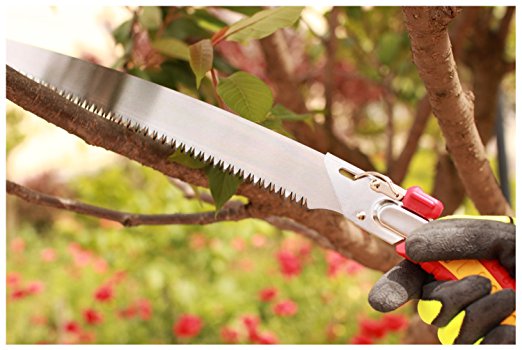Did you know the ideal time to prune your fruit trees is in mid- to late winter, before the sap starts to “wake up” from the roots and flows back into the branches?
If the tree’s already been pruned when it starts to form buds for Spring, that means all the energy in the roots can concentrate on growing only the limbs you’ve carefully chosen to leave in place.
About 4 weeks before the last frost date for your area is the ideal time to prune.

Why prune? Why not just leave things the way nature intended?
Well, in short–we have to prune fruit trees because we’ve already messed with nature enough that many of our best varieties have already been modified to the point that they will not grow properly without pruning.
The typical growth patterns of a commercially available fruit tree, if left alone, will usually cause the tree to produce much less fruit, and die young.
>> Check the botanical or scientific name of your fruit tree–the genus and species. If the named variety contains the word ‘prunus’, that means you’ve gotta prune it!
Here in Central Texas, if you haven’t pruned yet, you’re late! If you’re anywhere north of Texas, the time is soon!
The real problem with pruning fruit trees?
Okay, you’ve got your shears, you’re ready to go brave the chill. Now, how do you choose what to cut?
The biggest mistake that most people make when pruning trees is, they don’t prune aggressively enough! It’s fine to reduce a tree by up to 30% when you prune–and pruning in the Wintertime produces more vigorous Spring growth.
Also, don’t go cheap on your shears. A great pair of clippers will last a very long time, and cleaner, more precise cuts will let the wood heal more easily. We use TigerJaw hand pruners, and they are excellent.
How to prune…
Step One. First, take away any obviously dead, diseased, or damaged branches and twigs. Take out any low branches coming from the rootstock. Cut off any vertical branches (called ‘watersprouts’), which will be troublesome to harvest from in future!
Step Two. Then, look for how you can thin out the tree’s canopy, so that light and air can get to all the main branches. If two branches cross paths, choose one to keep and one to sacrifice. Your goal here is to leave about 6 to 12 inches of space around each branch, and to give the tree a symmetrical appearance.
Ideally, branches grow at about a 20-60 degree angle from the trunk. Too wide of an angle, and they may snap off when heavily laden with fruit–too narrow of an angle, and your fruit will be too high up to harvest easily!

Step Three. Finally, lop off the tips of any branches that are growing vigorously outward and upward, because this will encourage thick, strong limbs instead of spindly, thin ones.
Of course, there’s always differing opinions in gardening… Check out how one unconventional farmer, Paul Gautchi of Back to Eden, prunes his fruit trees for maximum ease of harvest!
He’s got a bad back, and so he trains all his fruit trees to grow downward, so he doesn’t have to reach very high!

 Get your own hand pruning saw here on Amazon!
Get your own hand pruning saw here on Amazon!


